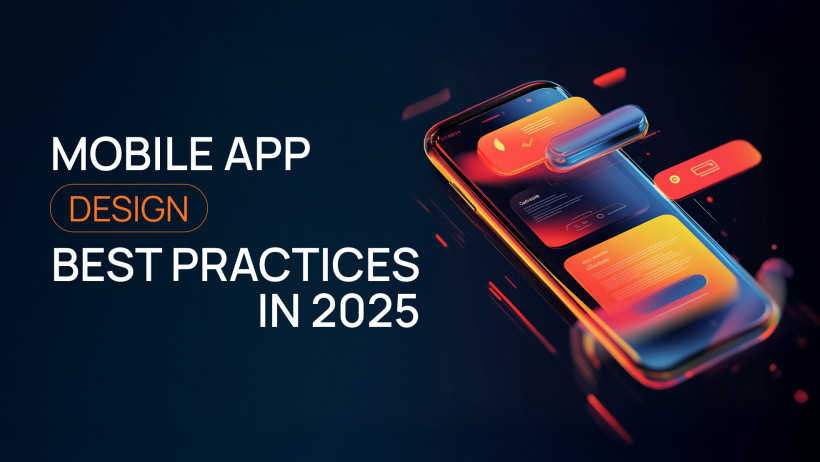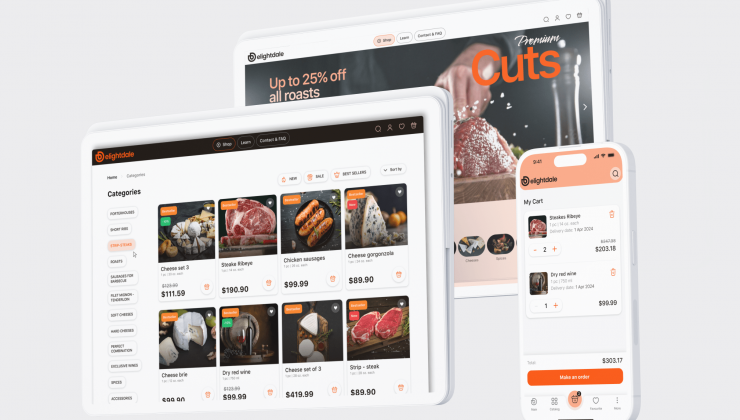In today’s crowded app marketplace, design can make or break your product. A few years ago, users were impressed if an app simply worked without glitches or crashes. Functionality alone was enough to stand out. But in 2025, expectations are higher than ever. Modern users are exposed to hundreds of polished apps every day, and their tolerance for poor design has dropped to zero.
Now, people don’t just want an app that works, they expect it to be beautiful, intuitive, and lightning-fast. The interface should feel natural from the very first tap, guiding them smoothly toward their goals without friction or confusion. An awkward onboarding process, cluttered layout, or even a few extra seconds of loading time can be all it takes for users to abandon an app and switch to a competitor.
This shift means that mobile app design best practices are no longer optional. They define whether your app succeeds or fades away in a highly competitive market. So, what exactly do users expect now? And how can businesses stay ahead by creating experiences that feel both modern and effortless?
Let’s dive into what works (and what doesn’t) in app UX design in 2025.
Why Design Quality Is Critical for App Success
Think about the last time you downloaded an app. How long did it take you to decide whether to keep it or delete it? For most users, it’s just a matter of seconds. That’s why app UX design in 2025 isn’t just about looking pretty, it’s about retention, trust, and revenue.
When an app feels polished and effortless to use, people immediately trust it. They sense that the brand behind it is professional, reliable, and user-focused. On the other hand, even a single confusing screen or awkward navigation pattern can spark frustration and cause users to abandon the app altogether.
Here’s why quality design plays such a decisive role:
- First impressions matter. If your interface feels clunky, outdated, or overloaded, users won’t give it a second chance. They’ll uninstall it and move on to one of the countless alternatives available.
- App Store reviews reflect design quality. Poor navigation, inconsistent icons, or hard-to-read text don’t go unnoticed. Dissatisfied users are quick to share negative feedback, which directly impacts your visibility and download rates.
- Revenue is tied to usability. Smooth checkout flows, clearly placed CTAs, and streamlined onboarding experiences reduce drop-offs and encourage conversions. Even small design improvements can have a measurable impact on business results.
In other words, great design is strategy. It shapes how users perceive your brand, whether they recommend your app to others, and ultimately, how profitable your digital product becomes.
Top Mobile UX Principles in 2025

Trends come and go, but some mobile app usability guidelines are timeless. In 2025, these principles remain at the core of successful design:
Simplicity and clarity
Less is still more. Avoid overloading screens with too many elements. Users want apps that get the job done quickly and clearly.
Mobile-first thinking
With mobile-first design dominating, every feature should be built with a small screen in mind first, then adapted for tablets or desktops.
Accessibility and inclusivity
Dark mode and accessibility features are no longer “nice-to-have.” They’re standard expectations. Color contrast, text resizing, and voice support ensure everyone can use your app comfortably.
Visual Design Trends

In 2025, UI/UX for mobile apps blends functionality with modern aesthetics. Here’s what’s shaping the look and feel of apps right now:
- Neumorphism and glassmorphism add depth and softness but must be balanced with readability.
- Micro-animations and transitions guide users through tasks without overwhelming them.
- Custom illustrations and 3D elements bring personality and uniqueness, setting your app apart.
These trends aren’t just visual decoration — they’re shaping the way app UX design 2025 looks and feels for users.
But remember: performance and design balance is crucial. Heavy graphics that slow down loading times do more harm than good.
UX Writing and Microcopy
Design isn’t only visual. Words on buttons, tooltips, and error messages can make or break the experience. Clear language and supportive tone are just as important as layouts or navigation. In fact, many of the best mobile app user interface tips focus on microcopy — the small words that guide users through their journey.
- Clarity over cleverness. Instead of “Oops! Something’s wrong,” say, “Check your internet connection and try again.”
- Tone of voice matters. Friendly, supportive language builds trust.
- Localization is key. Users expect UX writing that adapts to their language and culture seamlessly.
Good microcopy feels like a helpful guide, not a manual.
Key Screens to Design Right
Some screens are more critical than others. Nail these, and you’ll win your users’ loyalty:
- Onboarding experience – keep it short, engaging, and value-driven. Show users how the app solves their problems, not just what buttons to press.
- Home screen – prioritize what users need most. Clutter-free design with intuitive navigation keeps people coming back.
- Checkout and CTA flow – every extra step risks losing a customer. Use visual hierarchy in apps to highlight the next action.
- Settings and profile – don’t hide essential features. People want personalization without digging through endless menus.
UX Testing and Feedback Loops
Even the most polished design can fail without user validation. What looks perfect in a wireframe or prototype may not match how people actually interact with it. That’s why, in 2025, testing is faster, smarter, and continuous — not just a one-time step before launch.
- Usability testing helps you understand real-world behavior, not just assumptions. Watching users struggle (or succeed) with tasks provides insights that no analytics dashboard can fully capture.
- A/B testing UI elements — from buttons and layouts to color schemes, reveals what actually drives engagement and conversions. Small tweaks can lead to big improvements in performance.
- Feedback loops within the app — like quick surveys, contextual prompts, or star ratings, provide instant insight without disrupting the flow. They give users a voice and help you spot issues early.
The key is to treat testing as an ongoing conversation with your users. Great design evolves with feedback, market changes, and shifting expectations. The best apps are never “finished”, they’re always improving, adapting, and getting smarter over time.
Building with Design Systems
Consistency saves time and boosts quality. Modern teams rely on design systems for mobile that include reusable components, style guidelines, and interaction rules. These systems act as a single source of truth, ensuring that every element (from buttons to icons) follows the same logic.
- Design tokens define colors, typography, and spacing for scalability. This makes it easy to adjust branding or update styles across the entire app with minimal effort.
- Cross-platform consistency ensures your Android and iOS versions feel familiar but still respect platform-specific patterns. Users get a unified experience without feeling like the app was simply “copied and pasted.”
- Shared systems improve collaboration between designers and developers. Instead of debating how a button should look on each new screen, teams can focus on solving bigger UX problems, reducing costly rework and delays.
Well-structured design systems also make onboarding new team members faster, support long-term scalability, and help maintain brand integrity across multiple products.
In other words, design systems are a business asset that saves time today and prevents design debt tomorrow.
How WEZOM Designs User-Friendly, Business-Driven Apps

At WEZOM, we believe that great design is where user needs and business goals meet. An app should solve real problems, strengthen brand identity, and contribute directly to growth. That’s why our design process is built on strategy, creativity, and collaboration.
Here’s how we make it happen:
- Research-first approach. Every project begins with deep discovery. We analyze your audience, study market trends, and benchmark competitors to uncover opportunities and challenges. This ensures that our concepts aren’t based on guesswork but on real user behavior and business priorities.
- UI/UX design sprints. Instead of long, drawn-out cycles, we work in short, focused bursts that let us prototype, test, and refine ideas quickly. This iterative approach helps us validate assumptions early and save time and resources down the line.
- Collaboration with dev teams. Design doesn’t exist in a vacuum. Our designers work closely with developers to ensure that what looks good on screen is also technically feasible, scalable, and high-performing once built. The result is seamless handoff and fewer surprises during implementation.
- Continuous feedback loops. We don’t stop at launch. By collecting user feedback and analyzing performance data, we evolve the design to keep pace with changing expectations and business goals.
This methodology ensures that every app we deliver isn’t just eye-catching but also effective, scalable, and profitable. With WEZOM, you’re not just getting a design team, you’re gaining a strategic partner committed to helping your digital product thrive.

Conclusion
Mobile app design best practices in 2025 aren’t about blindly chasing every shiny new trend. Instead, they’re about creating meaningful experiences that meet user expectations, build trust, and drive long-term success. Trends like glassmorphism or 3D elements may catch attention, but what truly keeps people engaged is consistency, clarity, and a design that feels natural in their everyday lives.
When you prioritize intuitive navigation, accessibility, microinteractions, and strong design systems, you go beyond aesthetics. You’re shaping an app that people enjoy returning to, one that solves their problems without frustration and creates a positive emotional connection with your brand.
In today’s competitive landscape, design is more than a visual layer, it’s a strategic business tool. The right UX/UI choices can boost retention, increase conversions, and even turn casual users into loyal advocates.
So the question is: are you ready to build an app that doesn’t just look good, but delivers measurable results?
If the answer is yes, then let’s connect. Together, we can transform your idea into a product that’s both user-friendly and business-driven — something truly exceptional.


